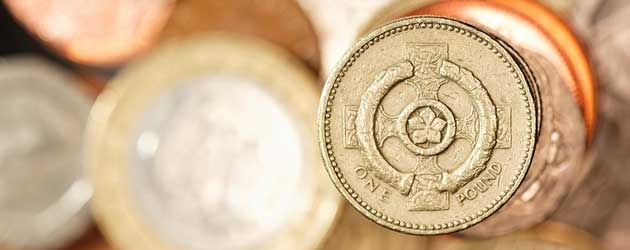The Pound Sterling to Euro (GBP/EUR) exchange rate edged up slightly on Wednesday prior to the release of the UK’s trade balance figures.
Pound Sterling to Euro (GBP/EUR) Exchange Rate Could Gain if UK Trade Data Impresses
With European data in short supply today, movement in the Pound Sterling to Euro (GBP/EUR) exchange rate is likely to be dictated by the UK’s trade balance figures.
It has been forecast that the trade deficit narrowed in October. If that proves to be the case, the Pound could climb.
The GBP/EUR exchange rate could also fluctuate following a speech to be given by the European Central Bank’s (ECB) Benoit Coeure.
The Pound Sterling to Euro (GBP/EUR) exchange rate extended declines as the European session continued and the UK’s Industrial/Manufacturing Production figures fell short of forecasts.
GBP/EUR Exchange Rate Down over 0.3%
With UK Manufacturing Production falling by -0.7% on the month in October (rather than rising the 0.2% expected) and industrial production declining -0.1%, demand for the Pound faltered during local trading and the Pound Sterling to Euro exchange rate (GBP/EUR) consolidated earlier losses.
According to the Office for National Statistics; ‘there were increases in eight of the 13 manufacturing subsectors compared with a year ago and the largest contributor was the manufacture of food products, beverages & tobacco. Total production in October 2014 is estimated to have decreased by 0.1% compared with September 2014. Manufacturing was the only one of the four main components to fall, decreasing by 0.7%. The main manufacturing components contributing to the fall between September 2014 and October 2014 were computer, electronic & optical products; basic pharmaceutical products & pharmaceutical preparations; and chemicals & chemical products. In the three months to October 2014, production and manufacturing were 10.4% and 5.5% respectively below their figures reached in the pre-downturn GDP peak in Q1 2008.’
The Pound Sterling to Euro (GBP/EUR) exchange rate was little-changed after the NIESR GDP estimate for November came in at 0.7%, as forecast.
Earlier…
The Pound Sterling to Euro (GBP/EUR) exchange rate shed 0.2% prior to the release of the UK’s industrial production and manufacturing production figures.
GBP/EUR Exchange Rate Weakened by German Trade Data
Early into the European session the Pound Sterling to Euro (GBP/EUR) exchange rate fell to a low of 1.2675 in response to trade data for the Eurozone’s largest economy.
The Euro derived some support from the news that, on a monthly basis, German exports surpassed the 100 billion-Euro threshold for a third time this year.
The nation’s trade surplus advanced from 17.8 billion Euros to 21.9 billion Euros on the year.
Exports were up 4.9% on the year while exports advanced 0.9% year-on-year.
On the month, exports fell by a seasonally adjusted -0.5% in October, bettering expectations for a fall of -1.7%.
Imports, on the other hand, fell by -3.1% on the month – almost double the -1.7% forecast. However, September’s import figure was positively revised to 5.2%.
According to economist Christian Schulz; ‘The weak imports are on the one hand a sign of weak domestic demand, but on the other hand they are a consequence of the slide in oil prices.’
Pound Sterling (GBP) Exchange Rate Fluctuates on BoE Comments
Meanwhile, the Pound Sterling (GBP) exchange rate experienced fluctuations as a result of comments issued by Bank of England (BoE) policymaker Martin Weale.
Weale asserted that higher interest rates might be needed in order to offset weak growth in productivity.
He asserted; ‘Persistently slower productivity growth would have two implications for interest rates. In the short term, interest rates would need to be higher in order to prevent demand running ahead of supply. But over the medium term, interest rates may remain lower than they were before the crisis, reflecting weaker underlying growth.’
Pound Sterling to Euro (GBP/EUR) Exchange Rate Forecast
In the hours ahead, notable Pound Sterling to Euro (GBP/EUR) exchange rate movement could be caused by the UK’s Manufacturing Production/Industrial Production reports.
Investors will also be paying close attention to the National Institute of Economic and Social Research’s UK GDP estimate for November.
Pound Sterling (GBP) Exchange Rates
[table width=”100%” colwidth=”50|50|50|50|50″ colalign=”left|left|left|left|left”]
Currency, ,Currency,Rate ,
Pound Sterling, ,US Dollar,1.5666,
,US Dollar,1.5666,
Pound Sterling, ,Euro,1.2679,
,Euro,1.2679,
Pound Sterling, ,Australian Dollar,1.8926,
,Australian Dollar,1.8926,
Pound Sterling, ,New Zealand Dollar,2.0403,
,New Zealand Dollar,2.0403,
US Dollar, ,Pound Sterling,0.6380,
,Pound Sterling,0.6380,
Euro, ,Pound Sterling,0.7887,
,Pound Sterling,0.7887,
Australian Dollar, ,Pound Sterling,0.5282,
,Pound Sterling,0.5282,
New Zealand Dollar, ,Pound Sterling,0.4892,
,Pound Sterling,0.4892,
[/table]

